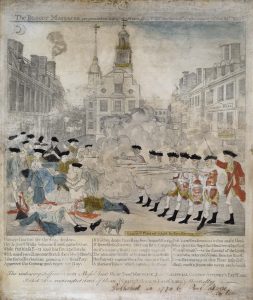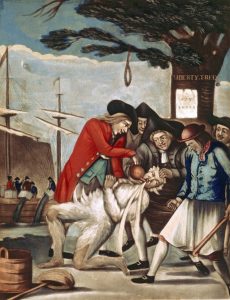In the eighteen century, American colonists rebelled against various taxes imposed by the British government. From 1764 to 1776, the British government placed taxes on a variety of goods in the American colonies including sugar, printed documents, lead, glass, paint, and tea. American colonists objected to these taxes. American colonists noted that they had no representation in the British Parliament which approved these taxes. American colonial assemblies passed resolutions in opposition to British taxation. American colonists organized boycotts of British made goods to resist taxation. A homespun movement emerged in colonial America as part of this boycott movement. American colonists also staged violent protests against taxation. Colonists assaulted customs houses and burned them to the ground. Colonists burned tax collectors in effigy and tarred and feathered tax collectors. The Sons of Liberty organized tea parties, seizing tea on ships and dumping it into the harbour as a protest against taxation. Ultimately, these protests would lead to a colonial rebellion against Britain.
American Tax Rebels
In 1764, the British Parliament passed the Sugar Act. The Sugar Act sought to combat widespread smuggling of molasses in New England by cutting the duty on sugar in half but increasing enforcement. With the enactment of the Sugar Act, some colonists began to fear a pattern of increased taxation and restricted liberties.
In March 1765, Parliament passed the Stamp Act. The act required many documents be printed on paper that had been stamped to show the duty had been paid. The Sugar Act of 1764 was an attempt to get merchants to pay an already-existing duty, but the Stamp Act created a new, direct tax. Parliament had never before directly taxed the colonists.
Resistance to the Stamp Act took three forms, distinguished largely by class: legislative resistance by elites, economic resistance by merchants, and popular protest by common colonists. Colonial elites responded with legislative resistance initially by passing resolutions in their assemblies. The most famous of the anti-Stamp Act resolutions were the “Virginia Resolves,” passed by the House of Burgesses on May 30, 1765. When the resolves were printed throughout the colonies, however, they often included a few extra, far more radical resolves, the last of which asserted that only “the general assembly of this colony have any right or power to impose or lay any taxation” and that anyone who argued differently “shall be deemed an enemy to this his majesty’s colony.” The spread of these extra resolves throughout the colonies led to the calling of the Stamp Act Congress in New York City in October 1765. Nine colonies sent delegates.
The Stamp Act Congress issued a “Declaration of Rights and Grievances,” which, like the Virginia Resolves, reasserted the idea that colonists were entitled to the right to only be taxed by their own elected representatives. Because the colonies did not elect members to Parliament, they believed that they were not represented and could not be taxed by that body.
The second type of resistance to the Stamp Act was economic. While the Stamp Act Congress deliberated, merchants in major port cities were preparing non-importation agreements, hoping that their refusal to import British goods would lead British merchants to lobby for the repeal of the Stamp Act. The plan worked. By January 1766, London merchants sent a letter to Parliament arguing that they had been “reduced to the necessity of pending ruin” by the Stamp Act and the subsequent boycotts.
The third, and perhaps, most crucial type of resistance was popular protest. Violent riots broke out in Boston. Crowds burned the appointed stamp distributor for Massachusetts, Andrew Oliver, in effigy and pulled a building he owned “down to the Ground in five minutes.” Oliver resigned the position the next day. The following week, a crowd also set upon the home of his brother-in-law, Lt. Gov. Thomas Hutchinson, who had publicly argued for submission to the stamp tax. Before the evening was over, much of Hutchinson’s home and belongings had been destroyed. Popular violence and intimidation spread quickly throughout the colonies.
By November 16, all of the original twelve stamp distributors had resigned, and by 1766, groups who called themselves the “Sons of Liberty” were formed in most of the colonies to direct and organize further popular resistance. These tactics discouraged colonists from accepting appointments as stamp collectors. With no one to distribute the stamps, the Act became unenforceable.
Pressure on Parliament grew until, in February of 1766, they repealed the Stamp Act. But Britain still needed revenue from the colonies.
Britain’s next attempt to draw revenues from the colonies, the Townshend Acts, were passed in June 1767, creating new customs duties on common items, like lead, glass, paint, and tea. The Acts also created and strengthened formal mechanisms to enforce compliance, including a new American Board of Customs Commissioners and more vice-admiralty courts to try smugglers. These acts increased the presence of the British government in the colonies and circumscribed the authority of the colonial assemblies. Unsurprisingly, colonists, once again, resisted.
New forms of resistance emerged in which elite, middling, and working class colonists participated together. Merchants re-instituted non-importation agreements, and common colonists agreed not to consume these same products. Lists were circulated with signatories promising not to buy any British goods. These lists were often published in newspapers, bestowing recognition on those who had signed and led to pressure on those who had not.
Women, too, became involved to an unprecedented degree in resistance to the Townshend Acts. They circulated subscription lists and gathered signatures. The first political commentaries in newspapers written by women appeared. Also, without new imports of British clothes, colonists took to wearing simple, homespun clothing. Spinning clubs were formed, in which local women would gather at one their homes and spin cloth for homespun clothing for their families and even for the community.
Homespun clothing quickly became a marker of one’s virtue and patriotism, and women were an important part of this cultural shift. At the same time, British goods and luxuries previously desired now became symbols of tyranny. Non-importation, and especially, non-consumption agreements changed colonists’ relationship with the mother country. Committees of Inspection monitored merchants and residents to make sure that no one broke the agreements. Offenders could expect to be shamed by having their names and offenses published in the newspaper and in broadsides.
Britain sent regiments to Boston in 1768 to help enforce the new acts and quell the resistance. On the evening of March 5, 1770, a crowd gathered outside the Custom House and began hurling insults, snowballs, and perhaps more at the young sentry. When a small number of soldiers came to the sentry’s aid, the crowd grew increasingly hostile until the soldiers fired. After the smoke cleared, five Bostonians were dead. News of the “Boston Massacre” spread quickly through the new resistance communication networks, aided by a famous engraving initially circulated by Paul Revere, which depicted bloodthirsty British soldiers with grins on their faces firing into a peaceful crowd. The engraving was quickly circulated and reprinted throughout the colonies.

Resistance again led to repeal. In March of 1770, Parliament repealed all of the new duties except the one on tea.
In April of 1773, Parliament passed an act to aid the failing East India Company, which had fallen behind in the annual payments it owed Britain. But the Company was not only drowning in debt; it was also drowning in tea, with almost 15 million pounds of it in stored in warehouses from India to England. So, in 1773, the Parliament passed the Tea Act, which would allow the Company to sell its tea in the colonies directly and without the usual import duties. This would greatly lower the cost of tea for colonists, but, again, they resisted.
Merchants resisted because they deplored the East India Company’s monopoly status that made it harder for them to compete. But the widespread support for resisting the Tea Act had more to do with principles. By buying the tea, even though it was cheaper, colonists would be paying the duty and thereby implicitly acknowledging Parliament’s right to tax them.
The Tea Act stipulated that the duty had to be paid when the ship unloaded. In November, the Boston Sons of Liberty resolved to “prevent the landing and sale of the [tea], and the payment of any duty thereon” and to do so “at the risk of their lives and property.” The meeting appointed men to guard the wharfs and make sure the tea remained on the ships until they returned to London. This worked and the tea did not reach the shore, but by December 16, the ships were still there. Hence, another town meeting was held at the Old South Meeting House, at the end of which dozens of men disguised as Mohawk Indians made their way to the wharf. The Boston Gazette reported what happened next:
But, behold what followed! A number of brave & resolute men, determined to do all in their power to save their country from the ruin which their enemies had plotted, in less than four hours, emptied every chest of tea on board the three ships . . . amounting to 342 chests, into the sea ! ! without the least damage done to the ships or any other property.

As word spread throughout the colonies, patriots were emboldened to do the same to the tea sitting in their harbors. Tea was either dumped or seized in Charleston, Philadelphia, and New York, with numerous other smaller “tea parties” taking place throughout 1774.
Popular protest spread across the continent and down through all levels of colonial society. Women across the thirteen colonies could most readily express their political sentiments as consumers and producers. Because women were often making decisions regarding which household items to purchase, their participation in consumer boycotts held particular weight. Some women also took to the streets as part of more unruly mob actions, participating in grain riots, raids on the offices of royal officials, and demonstrations against the impressment of men into naval service. The agitation of so many helped elicit responses from both Britain and the colonial elites.
Source: The American Yawp. A Free and Online, Collaboratively Built American History Textbook, 2017-2018 Edition.
American Tax Rebels Video
IFrame
Pulley, P. American Revolution, Part 1. (23 September 2014). [Video File]. Retrieved from https://www.youtube.com/watch?v=YWHoxxZR9nw
Summary
In the 1760s and 1770s, the British Parliament levied a number of taxes on American colonists. With enactment of the Townshend Acts, the British placed taxes on a number of products including lead, glass, paint, and tea. The Sons of Liberty was formed by American colonists opposed to British taxation. American colonists asserted that these taxes were illegitimate and protested against taxation without representation. The anti-tax protests were most intense in the city of Boston. American colonists protested outside of customs houses. Sometimes these protests became violent. One protest outside of a customs house in Boston ended with British soldiers opening fire into the crowd of protestors. Paul Revere dubbed this event the Boston Massacre in his engraving of the event. Many colonists participated in a boycott of British made goods. Women produced homespun clothing in support of the boycott. As a protest against the tax on tea, the Sons of Liberty organized the Boston Tea Party, dumping British tea into the harbor.
